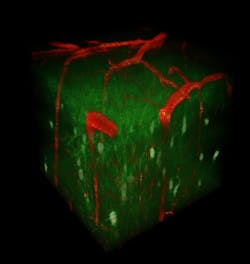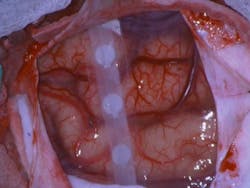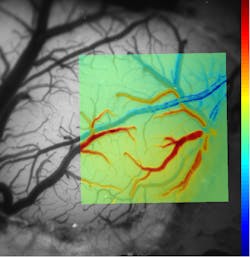NEUROSCIENCE/BIOPHOTONICS: The BRAIN Initiative: Opportunities for optics and photonics
Described by NIH Director Francis Collins as "our generation's moon shot," the White House Brain Research through Advancing Innovative Neurotechnologies Initiative—known as the BRAIN Initiative—is expected to transform neuroscience in much the same way as the Human Genome project revolutionized genetics. This ambitious five-year, $100 million program led by three federal agencies—the National Science Foundation (NSF), the National Institutes of Health (NIH), and the Defense Advanced Research Projects Agency (DARPA)—aims to create technologies to answer fundamental questions about how the brain operates.
No small order, but one that Elizabeth Hillman, an associate professor of biomedical engineering at Columbia University, thinks is ripe for optical techniques and devices. "This is a real opportunity for optics," says Hillman. She acknowledges that while many of the most popular approaches to brain research are optical—think two-photon microscopy, optogenetics, exposed cortical mapping, photoacoustics, diffuse optical tomography, and optical intrinsic signal imaging—these techniques could benefit from focused federal investment.Funding from the BRAIN Initiative could help resolve critical issues that plague optical approaches such as penetration depth, light scattering, and scanning and sampling speeds. Although current optical approaches allow researchers to learn more about the molecular and genetic activities of neural tissue, their physical constraints limit the kinds of information researchers can extract from areas deep in the brain. "The tools we currently have are just not enough. We can't get the information from the brain that we need," Hillman says.
Extending the reach of these and other techniques may supply critical insight into the workings of the brain's 100 trillion neural connections. Efforts to overcome technical hurdles associated with optical techniques are crucial because no other imaging modality offers the specificity and detail optics provides.
Is it worth it?
In the months since the BRAIN Initiative announcement in April 2013, critics have debated the initiative's cost. DARPA will provide $50 million in funding, NIH $40 million, and NSF $20 million. Some argue that $100 million is really too little money for such a bold effort. Others contend that initiating a $100 million project during sequestration will draw money away from other projects.However, while the federal investment tops out just over $100 million, private partners such as the Allen Institute for Brain Science, the Howard Hughes Medical Institute, the Kavli Foundation, and the Salk Institute for Biological Studies will also invest nearly $100 million annually in projects related to the BRAIN Initiative.
For those concerned about a drain on NIH neuroscience funding, it's important to keep in mind that the institutes provide $5.5 billion annually for neuroscience research and that will likely continue, even with this new initiative. During a YouTube briefing on the BRAIN Initiative, NIH's Collins put the initiative's price tag in perspective: "$100 million is just 0.3 percent of NIH's budget." He also suggested that if budgets loosen up, "we may be able to ramp up" efforts related to the BRAIN Initiative. One of his goals is to involve as many researchers as possible in the effort.
Involving the research community
DARPA Director Arati Prabhakar echoed Collins' commitment to the project. DARPA has wants to ensure researchers across the country consider ways to participate in the program. The agency will begin soliciting proposals this fall. During the same briefing, Prabhakar noted that since much of the work is basic research, DARPA will rely on laboratories and universities to develop technologies and begin using them to understand neural dynamics.Collins said that because the research is fundamental and pre-competitive, results from any BRAIN research will be made available to all through the Internet. "A core group may produce results, but after testing it to ensure it is quality data, we'll make it available," he said. As time passes, both Collins and Prabhakar anticipate opportunities for companies to translate this basic research into commercially and clinically viable products.
Over the summer, an NIH working group headed by Cornelia "Cori" Bargmann of the Rockefeller University and William Newsome of Stanford University held a series of workshops to elicit feedback from the research community on goals and directions the research should take over the next five years. In the spring, NSF also sponsored a workshop for neuroscience researchers to provide input on research advances and needs.
This fall, the NIH working group is expected to issue an interim report with recommendations for high-priority research for the 2014 fiscal year. The group's final report is due in June 2014 and will include timetables, milestones, and cost estimates for reaching those priority research goals.
Both current and yet-to-be-developed optics technologies will likely be an important option for neuroscientists as they embark on the president's challenge. As Hillman notes, "The key for optics is to find the right application for each technology. If this happens, we can do amazing science and the prizes are huge."




